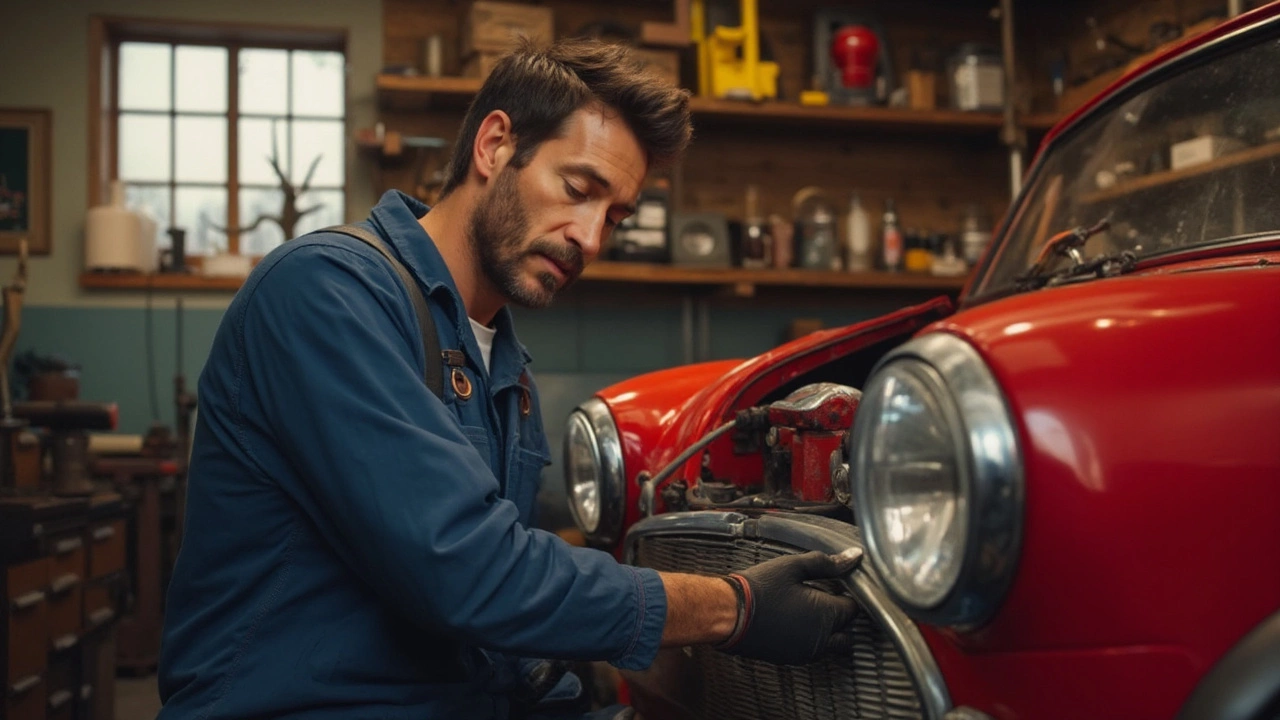Brake pads might not be the most glamorous part of your car, but they are definitely among the most crucial. Why? They literally stop your car! If you're wondering if replacing them is worth it, let's just say it's way more cost-effective than dealing with an accident or hefty repair bills down the road.
Think about your morning routine. You brew a cup of coffee, and just like that, your car's brakes are the coffee that keeps your safety awake every time you hit the pedal. But how do you know when they need some TLC? Well, if you’re hearing squeals or your car feels a bit slow to stop, it might be time to check those pads.
Brake pads wear down over time, requiring regular replacement to maintain optimal functionality. Ignoring worn brake pads can lead to more serious damage, decreased braking efficiency, and, frankly, scary moments on the road. It’s not just about safety; it's about peace of mind every time you drive.
- Why Brake Pad Replacement Matters
- Signs Your Brake Pads Need Attention
- The Costs Involved
- Types of Brake Pads Available
- DIY Replacement vs Professional Help
- Tips for Extending Brake Pad Life
Why Brake Pad Replacement Matters
Let's talk about why replacing brake pads isn't just another line item on your car's service bill—it's a big deal for your safety and your bank account. Brake pads are the unsung heroes of your vehicle's braking system, and their health directly affects how well you can stop your car when you need to.
Consider this: your car's stopping power isn't just based on pressing the brake pedal. It's all about the condition of those brake pads. They press against the brake rotor to create the friction needed to stop your car smoothly and safely. Worn-down pads mean less friction, which means that stopping takes longer—definitely not what you want in an emergency!
Safety First!
Old or worn brake pads can significantly increase your stopping distance. Think about driving down the highway and needing to stop suddenly. Those extra few feet could mean avoiding an accident altogether. Additionally, constant wear on the brake pads can lead to damage to the rotors or other braking components, which are much pricier to fix.
When to Change Brake Pads?
Not sure when they need replacing? Watch for these signs: a high-pitched squeal when braking, a grinding sound, or longer stopping distances. Generally, brake pads should be checked every 10,000 to 15,000 miles, but always refer to your vehicle's manual for specifics.
Cost vs. Value
While replacing brake pads might feel like an inconvenience at first, it's a cost that pays off. Skipping a brake pad replacement to save money today could lead to costly repairs later—rotor replacement, anyone?
| Average Brake Pad Lifespan | Cost of Replacement |
|---|---|
| 30,000 to 70,000 miles | $100 to $300 (per axle) |
| Professional Repairs Needed | $300 and up |
Simply put, getting your brake pads replaced regularly is a must. It ensures safety, saves on potential future expenses, and keeps your vehicle running smoothly. It's like giving your car a much-needed spa day—treat it right, and it’ll take care of you.
Signs Your Brake Pads Need Attention
Wondering if those squeaky sounds are trying to tell you something about your brake pads? You're probably right. Ignoring these signs can lead to costly repairs or even dangerous situations.
Noisy Brakes
One of the most obvious signals is noise. If you hear a squealing or screeching sound when you hit the brakes, it's a crying plea for help from your brake pads. This noise often comes from a small indicator in the pad that grates against the rotor when it's time for a change.
"Your car's brake system is an intricate dance of parts, each with their vital role. Pay attention to the orchestra of noise, as it often signals when something is out of tune." - Mark Thompson, Automotive Expert
Decreased Performance
Do you feel like you're pressing the pedal harder or longer to stop? This is a classic sign of worn-out brake pads affecting performance. It might feel like your car's taking longer to come to a halt, which can be a big safety hazard.
Visual Check
You can actually take a look at your brake pads to see their condition. Peek through the spaces in the wheels, and what you're looking for is the thickness of the pads. If they seem less than a quarter-inch thick, it's probably time for a visit to the mechanic.
Vibration or Pulsation
Ever felt a shake or vibration through the pedal when braking? This could indicate warped rotors but also suggest thinning or uneven brake pad wear. Both situations need prompt attention.
| Warning Sign | Description |
|---|---|
| Squealing | High-pitched noise while braking |
| Reduced Stopping Power | Longer stopping distances |
| Visual Wear | Pads thinner than quarter-inch |
| Pedal Vibration | Shaking when applying brakes |
Keep these signs in mind to ensure your car maintenance stays in check, providing you with safety and peace of mind on the road. Taking care of your brake system means staying attentive to any unusual signs, and when in doubt, trust your instincts and get them checked. After all, it's better to be safe than sorry!
The Costs Involved
So, you're thinking about replacing those brake pads, and the first question that probably pops into your head is, "How much is this gonna hurt my wallet?" Well, it varies, and here's the lowdown on what you're looking at cost-wise.
First off, let's talk parts. Standard brake pads can run you anywhere from $25 to $75 for just the parts. If you’re going for high-performance or specialty pads, expect prices to climb upwards of $100 per set.
Labor Costs
Then there are the labor costs if you're not the DIY type. Labor typically ranges from $100 to $150 per axle depending on the shop and your vehicle's make and model. This means you might be looking at a total of $125 to $225 per axle if you choose professional service.
Additional Expenses
Keep in mind, the price varies depending on where you live. Big-city labor rates tend to be higher than those in smaller towns. Plus, if your brake rotors also need replacing, that could add another $30 to $200 to your bill, depending on the type and quality.
For some context, check out this quick breakdown of costs:
| Item | Cost Range |
|---|---|
| Brake Pads (per set) | $25 - $75 |
| Labor Cost (per axle) | $100 - $150 |
| Rotors (if needed, per set) | $30 - $200 |
When budgeting for replacing brake pads, it's a good move to set aside a little extra for unexpected costs. Always get a quote in advance, and don’t be afraid to shop around for the best deal.
Remember, spending a bit now on new brake pads could save a lot later on more significant repairs—or worse, an accident. So yeah, it’s pretty worth it.

Types of Brake Pads Available
Choosing the right brake pads for your car can feel like picking the right coffee blend—a bit overwhelming but totally worth it. Each type of brake pad has its pros and cons, and it's all about finding the best fit for your driving needs.
Semi-Metallic Brake Pads
Semi-metallic pads are like the sturdy old boots of the brake pad world—time-tested and reliable. These pads are composed of 30% to 65% metal and are known for their durability and good heat dissipation. Perfect if you live in a cooler climate or need strong stopping power. But they’re a bit noisier and might wear down your rotors faster than other types.
Ceramic Brake Pads
The sophisticated cousin in the brake pad family, ceramic pads offer quieter stops and longer-lasting components. Made from ceramic fibers and other materials, they produce less dust and are quieter than semi-metallic pads. They’re also less abrasive on the rotors. However, they might be pricier and aren't always the best choice if you're more of a heavy-duty driver or into speed.
Organic Brake Pads
Composed mostly of organic materials like rubber, glass, and resins, organic pads are quiet and gentle on the rotors. They're the eco-friendly choice for those who prioritize smooth and quiet braking over durability and heat management. These aren't as great in extreme temperatures but work just fine for most day-to-day driving.
Low-Metallic NAO Brake Pads
If you're somewhere between semi-metallic and organic, low-metallic NAO pads may be your jam. They have a bit more metal than fully organic pads, which helps with heat transfer and braking efficiency. Yes, they create more dust, but they also offer a balance of performance and noise reduction.
Considering a new set of brake pads? Think about your driving style, the typical climate you face, and, of course, your budget. Each option has something unique to offer, and picking the right one can make all the difference in your driving experience.
DIY Replacement vs Professional Help
Deciding whether to replace your brake pads yourself or to call in the pros can depend on a few factors. Let's break it down, shall we?
When to Go DIY
If you have some basic mechanical skills and a good set of tools, doing it yourself can save you a bit of cash. Plus, it's satisfying to know you can tackle something as essential as your car's brakes. Here's when going DIY might be a good idea:
- You’re familiar with the basic workings of your vehicle.
- You have access to the proper tools, like a jack, lug wrench, and brake pad spreaders.
- You enjoy hands-on work and have the time to spare.
- Your vehicle’s brake system is straightforward, without complex electronics.
Being a DIY mechanic isn't just about saving money; it’s also about learning and understanding your car more intimately. However, remember the stakes are high. If unsure, it's better to play it safe.
Calling in the Professionals
Now, if you're more comfortable with a pro handling brake maintenance or if your vehicle has a complex braking system, heading to a repair shop is the wisest move. Here's why:
- Professional mechanics have the expertise to spot other potential issues.
- You'll get a warranty or guarantee for their work, offering peace of mind.
- Some modern cars come with advanced braking technology that requires specialized knowledge.
- They usually have the parts you need on hand, saving you a trip or two.
While it might be a bit pricier than doing it yourself, sometimes the assurance of a job well done by someone who replaces brake pads day in and day out is worth the extra cost.
In terms of cost, DIY can average between $20 to $100 for parts, whereas professional services can range from $150 to $300, depending on your vehicle and location.
Tips for Extending Brake Pad Life
Taking care of your brake pads is not just about safety, it's also about making the most of your investment. Here's how to keep them going strong and save some money in the long run.
1. Avoid Aggressive Driving
Speeding up just to slam on the brakes is a sure way to wear out those pads quicker than you'd like. Maintaining a safe distance from the car in front and anticipating stops can help keep you smooth and steady on the road.
2. Lighten the Load
It might sound obvious, but the less weight your car carries, the easier it is on the brake pads. Regularly clean out your trunk and remove any unnecessary heavy items.
3. Regular Inspections
Getting your brakes checked regularly, even if it’s DIY, can help spot early signs of wear. Look for thinning pads or any signs of damage.
4. Use Engine Braking
On downhill stretches, using engine braking (downshifting gears) can reduce reliance on brake pads. This technique takes some getting used to but can extend the life of your pads.
5. Invest in Quality
Sometimes spending a bit more upfront on high-quality brake pads can mean longer life and better performance. Cheap pads often add up in costs and headaches.
"Braking systems are only as good as their least-maintained part. Regular care can greatly impact performance," says Tom Hardy, automotive expert at CarSafetyOnline.
6. Watch the Weather
Brake pads can suffer in extreme weather conditions. If you live in an area with harsh winters or hot summers, consider pads designed for those conditions.
Vehicle safety isn't something to compromise on. Keeping an eye on your brakes and taking simple steps like these can help you extend their lifespan and stay safe on the road.




